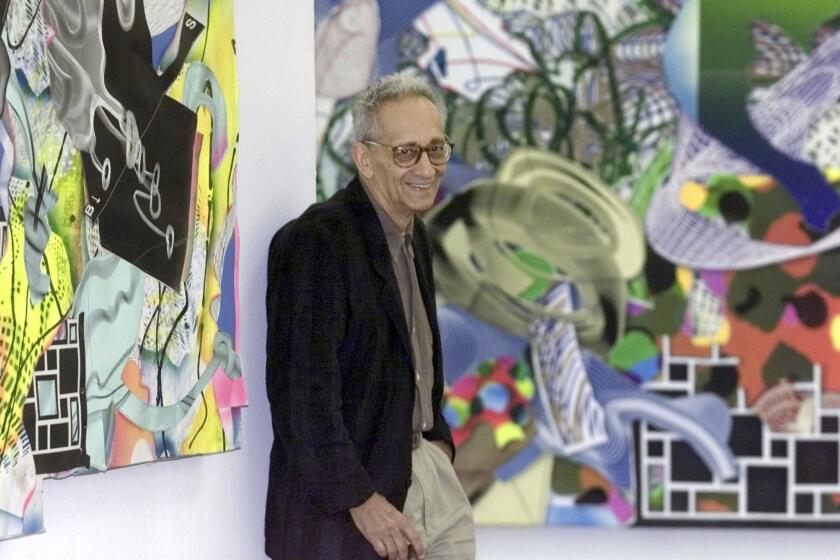‘NO TRADITIONS AND NO PRECEDENT’ FOR BUTOH
“Making our dances is like composing a haiku ,” explains Akaji Maro, director of Dai Rakuda Kan, the Japanese Butoh company performing at the Wadsworth Theater on Thursday, Saturday and next Sunday.
“In haiku , each word has no relation to the other words, but together, it is a collage. This is the way we make our dances.
“It is a collage of modern and old styles. It is like Surrealism. Like Salvador Dali’s paintings, we bring together different elements to create energy.”
Dai Rakuda Kan, one of Japan’s oldest and most prominent Butoh companies, first brought its surreal, non-verbal theater to the U.S. in 1982, performing at the American Dance Festival and at the Pepsico Summerfare in Purchase, N.Y. But Butoh as a movement began three decades before, with the dance-theater performances of Tatsumi Hijikata and Kazuo Ohno.
Clearly rooted in Eastern philosophies and sensibilities, including Zen, Butoh is difficult to define in conventional theatrical terms. At various times, it refers to and borrows from not only traditional Japanese theater forms such as Noh and Kabuki, but German Expressionism, Surrealism and Dadaism as well.
Maro, who is a disciple of Hijikata, mentions everyone from Dali to Prometheus as he tries, with both charm and passion, to explain his work. However, in accounting for Butoh’s appeal to American audiences, Maro has a simple explanation:
“It’s so different. There are no traditions and no precedent for this style of performance. When the audience looks at us, one story turns upside down, turns into a different story. These different stories together create one energy.
“It’s just like a picture, only unlike, say, Kabuki, which blows everything up into a big picture, Butoh telescopes everything down,” Maro says. “It concentrates everything into essentials.” On this tour, Dai Rakuda Kan will perform “The Five Rings,” a full-length work for a cast of 16, which premiered at the 1985 Butoh Festival in Tokyo. The set is elaborate, and the components of an original sound score will be mixed live during each performance.
“The Five Rings” deals with the five forces that make up the universe--earth, wind, fire, water and sky--and is based on a 17th-Century manual of Zen swordsmanship of the same title.
Unlike the manual, which encourages harnessing these five forces for personal gain (and has, recently, gained popularity as a metaphor for corporate competitiveness), Maro’s work is a view of the world through the eyes of a seeker of truth. He sees man’s strength--and survival--as predicated on coexisting with these forces.
“Japan is small,” Maro says. “Prometheus gave us fire and now human culture is moving toward danger.
“But this isn’t a political work in terms of the Left or the Right,” he explains. “Those aren’t the concerns. They are, instead, human and eternal concerns.”
Listening to Maro attempt a description of his work, one is reminded that Butoh is a post World War II development, and that the atomic-bomb blasts in Hiroshima and Nagasaki played a very large--if not the largest--part in the formation of the artistic consciousness of his generation.
One is also reminded of the inherent difficulty in describing an art form that must be experienced to be understood. Clearly much more comfortable moving than talking, Maro now gets up from his chair to demonstrate “walking.”
A deep guttural sound starts low in his chest and fills the room as he manages startling transformations, metamorphosing from one walking style to another: a young man; his grandmother; a farmer.
“Our training is not directly from ballet or modern dance. It’s our own original style,” he says when he is done and seated again. “Usually walking is done just by the foot. With us, it’s by the imagination.”
Maro is credited with introducing Butoh’s now-famous “look:” body paint and shaved heads. This look has been adopted by other Butoh groups founded by former Dai Rakuda Kan members, including Sankaijuku.
He compares himself to the famous 17th-Century haiku poet Basho, whose poems rely on simile and metaphor, juxtaposing two or more images without comment. Interpretation is redundant.
His own work, he says, is infused with Wabi , Sabi and Aware : traditional aesthetic terms that describe distinctly Japanese feelings, including an appreciation of the things in life that are both sad and beautiful because they are soon to die.
“When each person looks at a tree, he looks in a different way,” says Maro. “But we’re all the same. France. Russia. America. We’re humans.
“Every human has a grandfather. A grandmother. And a mother. We’re the same.”
More to Read
The biggest entertainment stories
Get our big stories about Hollywood, film, television, music, arts, culture and more right in your inbox as soon as they publish.
You may occasionally receive promotional content from the Los Angeles Times.






